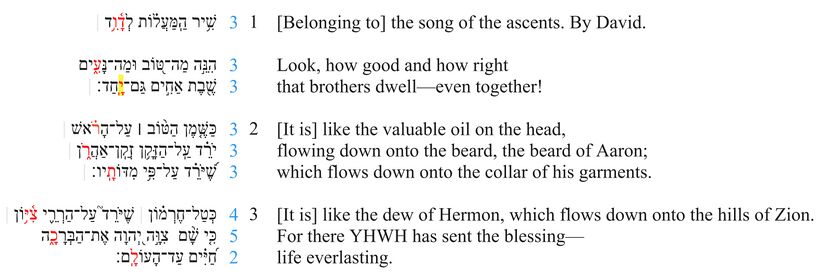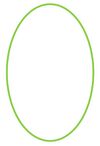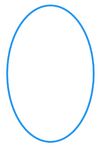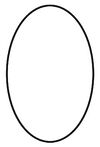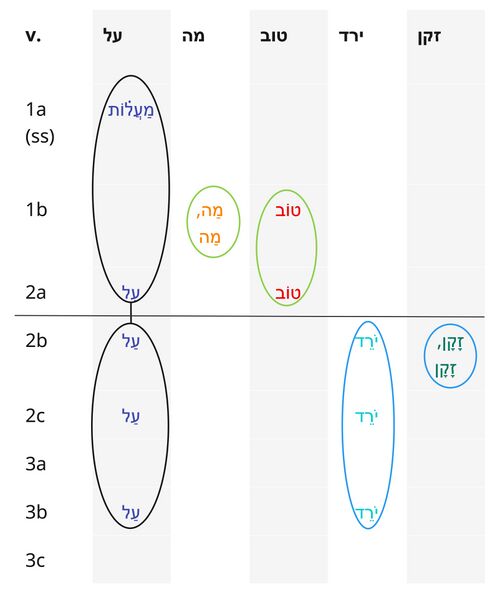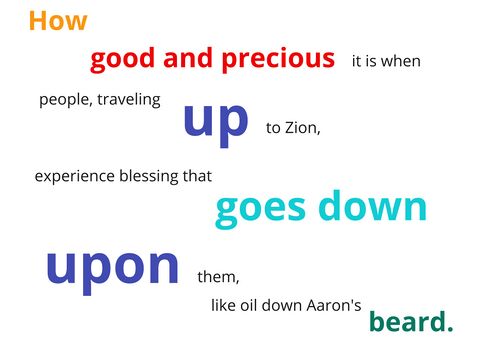Psalm 133 Poetics
About the Poetics Layer
Exploring the Psalms as poetry is crucial for understanding and experiencing the psalms and thus for faithfully translating them into another language. This layer is comprised of two main parts: poetic structure and poetic features. (For more information, click 'Expand' to the right.)
Poetic Structure
In poetic structure, we analyse the structure of the psalm beginning at the most basic level of the structure: the line (also known as the “colon” or “hemistich”). Then, based on the perception of patterned similarities (and on the assumption that the whole psalm is structured hierarchically), we argue for the grouping of lines into verses, verses into sub-sections, sub-sections into larger sections, etc. Because patterned similarities might be of various kinds (syntactic, semantic, pragmatic, sonic) the analysis of poetic structure draws on all of the previous layers (especially the Discourse layer).
Poetic Features
In poetic features, we identify and describe the “Top 3 Poetic Features” for each Psalm. Poetic features might include intricate patterns (e.g., chiasms), long range correspondences across the psalm, evocative uses of imagery, sound-plays, allusions to other parts of the Bible, and various other features or combinations of features. For each poetic feature, we describe both the formal aspects of the feature and the poetic effect of the feature. We assume that there is no one-to-one correspondence between a feature’s formal aspects and its effect, and that similar forms might have very different effects depending on their contexts. The effect of a poetic feature is best determined (subjectively) by a thoughtful examination of the feature against the background of the psalm’s overall message and purpose.
Poetics Visuals for Psalm 133
Poetic Structure
Poetic Macro-structure
Notes
- This psalm has three sections: a 4-line section in the middle (vv. 2-3a), sandwiched by two 2-line sections (1b-c and 3b-c).
- Verses 2-3a are united as a group for the following reasons:
- Use of of a nominal clauses (an elided subject and verb) followed by a simile using כְּ and a liquid (either oil or dew; boxed in light blue).
- The frequent repetition of the key words עַל and יֹרֵ֗ד (in participle form)
- The first section (1b-c) is linked to the last section (3b-c) by the following features:
- Deictic terms (הִנֵּ֣ה and שָׁ֨ם)[1]
- Alliteration (אַחִים "brothers" and חַיִּ֗ים "life") followed by an emphatic/intensified expression (גַּם־יָחַד "indeed together" and עַד־הָעוֹלָם "until forever").
- (Note: both the previous features not only serve as connections between the first and last sections of the psalm, but also as inclusios for the whole psalm as a unit.)
- There is an important repetition of the key word טּוֹב (tov) in 1b and 2a, which could be considered similar beginnings between the first two sections, especially with the two טּוֹב being preceded by an 'ah' sound (mah and ha).
- The last section is linked to the second section by similar beginnings in 2a and 3b: כַּשֶּׁ֤מֶ and כִּ֤י שָׁ֨ם, which have similar sounds (k + sh + m).[2]
- There is an additional sound play at work creating a pivot between v. 3a and v. 3b: צִיּ֥וֹן and צִוָּה.
Line Division
Notes
- V. 1b: This enjambment is supported by the accent on נָּעִ֑ים, and the traditions of the LXX, Codex Sassoon and 11Q5.
- V. 3: Although five prosodic words to two in vv. 3b-c may seem too imbalanced, כִּ֤י שָׁ֨ם are both monosyllabic. This division is also found in the LXX. Van der Lugt[3], however, considers כְּטַל־חֶרְמ֗וֹן as a separate line, which would result in 1-3-5-2 words.
Poetic Features
1. Liquids
Feature
In the field of phonetics, there are certain types of sounds that are made with minimal air restrictions; this means that air can flow relatively unobstructed through the mouth and nose. These sounds include vowels, as well as a type of consonant called approximants, which are smooth, vowel-like sounds.
Of the 7 most frequently occurring consonants in this poem, 6 are approximants, which include all of the approximant consonants that exist in Hebrew:
- lamedh ל
- resh ר
- mem מ
- nun נ
- yod יּ
- waw ו
Additionally, the vowel sound o (marked with a star) is frequently used and significant in this psalm. It occurs in the first and last lines of the body of the poem (1b and 3c), linking these two lines that are also connected in other ways. O also occurs frequently in 2a-3a, which is an important section because it gives the two pieces of imagery (oil and dew) which are crucial to the message of the psalm.
Also interesting to note is the high frequency of the sounds ל and ר in this section with the liquid imagery (and their total absence in 1b-c). These two sounds are a subclass of approximants called liquids.
Effect
Though certainly the psalmist did not have our modern understanding of, and labels for, phonetic sounds in language, a skilled poet like David would be able to identify the softer and harsher sounds in their language, and use them to their poetic advantage. There's good evidence that the Hebrew poets often employed sound play to imitate real-life sounds--often called "text painting" by musicians and artists. Here, these "flowy", unobstructed sounds mimic the sound of flowing of water or other liquids (like oil) (cf. Eccl. 1:7, which uses lamedh and mem to imitate the rolling and depth of moving waters).[4] The sounds of lamedh and resh, especially, are associated with the flowing of liquid,[5] so it's not surprising to see that the section with the liquid metaphors of oil and dew (2a-3a) are filled with these consonants, as well as the rounded O vowel.
It's also significant that these same sounds are included in two of the key repeated words in this psalm, עַל and יֹרֵד, which will be explored in the next feature....
2. Go with the Flow
Feature
The most-repeated words in this psalm are significant. First, there is an unusual candidate for most-repeated root: a preposition! עַל, meaning "on" or "onto", is repeated four times in just two verses (see also מַּעֲל֗וֹת in the superscription). Then, in a psalm that has only three distinct verbs, the participle יֹרֵ֗ד ("flowing/flows down") is repeated three times. These two words appear only in the middle section of the poem, 2a-3a.
Effect
The words that the psalmist chose to repeat (quite significant for such a short psalm) contribute to the liquid imagery (oil and dew) that is being conveyed. As the audience hears the repeated verbal idea of flowing down, combined with the frequent onto....onto....onto...it reinforces the mental image of liquids cascading downward, much like the blessing of life everlasting that YHWH gives. The end, or destination, of this downward movement is Zion (v. 3a), the place where YHWH has sent his blessing. Zion is the place of meeting between heaven and earth; God's blessings come down to Zion, and God's people come up to Zion.
3. Be Together
Feature
Psalm 133 chooses two very specific images to communicate the ideas of unity and blessing that are central to the psalm. The first image is that of anointing oil flowing down Aaron’s head, over his beard and onto his collar. Aaron was anointed by his brother, Moses, to be the first high priest of Israel. The consecration of Aaron included pouring anointing oil on his head, which designated him as selected by God for the specific role of the priesthood (Exod 29-30). The anointing oil was made of the finest spices: liquid myrrh, fragrant cinnamon, an aromatic cane, cassia, and olive oil (Exod 30: 23-24). This blend made a sacred anointing oil (Exod 20: 25) which was used to set apart people and objects for the service of God. It was not to be used "for practical, cosmetic, decorative, or luxurious reasons (Amos 6:6)."[6] Furthermore, Israelites were forbidden from recreating the sacred oil for profane use or putting any of it onto an outsider (Exod 30:33). The anointing of the priesthood was a blessing from God to the people who would have someone to seek God's forgiveness (Exod 32:11-14; Lev 16:15-16) and blessings on their behalf (Num 6:24-26). The oil ratified the covenant that established God’s dwelling and lordship among his people (Exod 29: 44-46). The mention of oil flowing down to Aaron’s beard may illustrate a peaceful and joyful celebration in the land, i.e., Zion. Shaving off the beard was regarded as dishonor and humiliation (2 Sam 10:4), it was a symbol for mourning (Jer 41:5; Ezra 9:3), and it was also a representation of the destruction and depopulation of the land of Judah (Ezel 5:1).[7] By contrast, oil flowing down Aaron’s beard marks the occasion of joyful celebration and fellowship as brothers from across the land congregate in Jerusalem to worship God.
The second image is that of dew of Hermon flowing down onto the hills of Zion. Dew consists of many small droplets of water which are essential during the summer when there is no rain. In Israel, water is the essential resource the land needs to prosper; without it, agriculture is difficult and food is scarce (droughts and famines are the result of insufficient water). Mount Hermon is known for its abundant amount of dew, and is thus an important water source for the arid land. Because Hermon is located hundreds of kilometers north of Jerusalem, dew does not literally flow from Hermon to Zion. Rather, the figurative scenario (imagery) of dew flowing from the far northern mountain of Hermon all the way to the arid southern mountains of Zion depicts both the volume and extent of God's blessings. God's life-giving power, characterized by dew, covers and nourishes the entire land. Additionally, like the dew, brothers will gather in Zion from all over the country to worship God together, an event which is itself a blessing.
Effect
These images work together to depict the blessedness that is brothers dwelling together in Zion. This blessedness derives from the covenant, which becomes the guarantor of God's favor and blessings, present and future.
- 1. Both the dew and the anointing oil symbolize God’s favor in accordance with the covenant (cf. Gen 27: 28; Deut 33:13-17; Isa 61:3; Ps 45:7 [H 8]). God promised to bring his people into a land watered by the dew from heaven (as opposed to the Nile) and the anointing oil represents the priesthood which maintains the covenant. Psalm 133 celebrates the blessedness of brothers dwelling together under the covenant (tangibly, at festivals in Jerusalem), which brings God's favor.
- 2. Both the oil descending from Aaron’s head to his beard and garments, and the dew flowing from north (Hermon) to south (hills of Zion), as mentioned in the other features, are downward, flowing motions. In the same way, the blessings of God “flow down” from above to Zion, the place where God and people meet. The goodness celebrated is more than the natural goodness of the earth: it is the goodness that descends from above, as God’s gift to the people.
- 3. The oil used for consecrating priests was a visible sign of a sacred calling. Likewise, the brothers dwelling together in unity in Jerusalem is understood as manifesting their own sacred calling to serve God as a kingdom of priests and a holy nation (Isa 61:6; Lev 11:44-45, 19:2, 20:26; 1 Pet 1:15-16; etc.).
- 4. The images reveal that the blessings associated with covenant are to be seen as valuable and sacred (like the anointing oil), and essential for life (like the dew of Hermon). In Zion, where brothers celebrate the covenant, they experience and celebrate the blessing of life everlasting, that is, ongoing life in a fruitful land in covenant unity with each other and with YHWH, mediated by the priesthood.
The images depict the covenant transforming ordinary family life into an experience of divine, eternal blessing.
Repeated Roots
(For more information, click "Repeated Roots Legend" below.)
| Repeated Roots legend | |
|---|---|
| Roots occurring only in the first half of the psalm are indicated in a green circle. | |
| Roots occurring only on the second half of the psalm are indicated in a blue circle. | |
| Roots occurring in both halves of the psalm are indicated in a black circle. | |
| Roots connected across sections are indicated by a vertical black line connecting the roots. | |
| The Mid-point for the repeated roots is indicated by a horizontal black line across the chart. | |
Bibliography
- Carpenter, Eugene. 2016. Exodus. Vol. 2. Evangelical Exegetical Commentary. Bellingham, WA: Lexham Press.
- Fokkelman, J.P. 2003. Major Poems of the Hebrew Bible: At the Interface of Prosody and Structural Analysis (Vol 3: The Remaining 65 Psalms). Vol. 3. Studia Semitica Neerlandica. Van Gorcum.
- Kirtchuk, Pablo. 2011. "Onomatopoeia and Phono-Iconicity in Hebrew in the framework of LUIT: Language - a Unified and Integrative Theory."
- Lugt, Pieter van der. 2013. Cantos and Strophes in Biblical Hebrew Poetry III: Psalms 90–150 and Psalm 1. Vol. 3. 3 vols. Oudtestamentische Studiën 63. Leiden: Brill.
- Zogbo, Lynell, and Ernst R. Wendland. 2020. Hebrew Poetry in the Bible: A Guide for Understanding and for Translating. Second. UBS Helps for Translators. Miami, FL: United Bible Societies.

